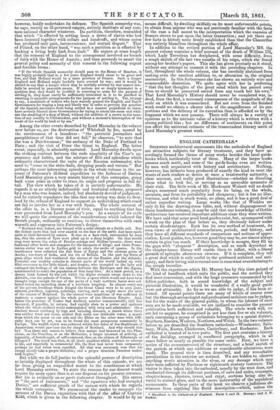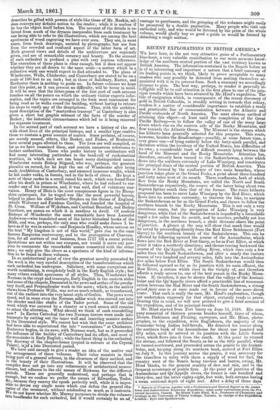ENGLISH CATHEDRALS.*
SpLurrina architectural monuments like the cathedrals of England are attractive subjects for literary treatment, and they have ac- cordingly formed the theme of many works besides the local guide- books which incidentally treat of them. Many of the larger books possess much merit, and some of the guide-books even are written by men well acquainted with history and architecture. Notbi g, however, has hitherto been produced of exactly the kind to meet the wants of such readers as desire at once a trustworthy authority, a clear account, and really good illustrations—whether as directing them what to look for, or serving as an agreeable memento of their visit. The little work of Mr. 'Mackenzie Walcott will no doubt always command much popularity from its being, on the whole, accurate, and from its portability and cheapness; but it has no illus- trations, and what is much worse, no plans, and it has a good deal of rather superfine writing. Large works like that of Winkles are only fit for the drawing-room table, and, without disparagement to those handsome volumes, it may be said that our knowledge of Gothic architecture has received important additions since they were written. We have said that some good local guides exist, but, as compared with a work on the plan of that before us, they obviously labour under certain disadvantages. Each has its own method of treatment, its own views of architectural nomenclature, periods, and history, and they have all different standards of comparison and notions of appre- ciation. Local guides, too, however good they may be, are almost always certain to give too much. If their knowledge is meagre, they fill up the gaps with " eloquent " description, and as much dryasdust as the chapter-house library will enable them to inflict, with a liberal garnish of epitaphs obseurorum virorum. If it is complete, they tell a great deal which is only useful to the professed architect and anti- quary, and their loving and reverend care is somewhat overwhelming, to the simple traveller.
With the experience which Mr. Murray has by this time gained of the kind of handbook which suits the public, and the method they find most convenient, and with the large resources commanded by his fellow-publisher, both in sound knowledge of the subject and pictorial illustration, it would be wonderful if a really good guide were not attainable. As far as we are able to judge, it has been at- tained. Of special points there are many of which of course none bat the thorough archreologist and professional architect can be judges, but for the wants of the general public, to whom the labours of such men are to be made available, we are inclined to consider the present publication both sufficient and valuable. The whole work will, we are led to suppose, be comprised in not less than five or six volumes, each containing a group of cathedrals belonging to a special district, Southern, Eastern, Western, Northern, andWelsh. In the two volumes before us are described the Southern cathedrals—Winchester, Salis- bury, Wells, Exeter, Chichester, Canterbury, and Rochester. Each cathedral is treated of in two parts. The first part contains a history of the building, arranged in numllered paragraphs, which in all cases follow as nearly as possible the same order. First, we have a notice of the commencement of the structure, and a brief sketch of the periods at which any additions or considerable alterations were made. The general view is then described, and any remarkable peculiarities in the exterior are noticed. We are bidden to observe anything worth attention in the close, or any damage which may have been inflicted by Puritans or eighteenth century restorers. The visitor is then taken into the cathedral, usually by the west door, and conducted through its different portions, of nave and aisles, transepts, chapter-house, cloisters, tower, and crypt, sections being also de- voted to stained glass, and to the more noteworthy of the sepulchral monuments. In these parts of the book we observe a judicious ab- stinence from anything like florid description—which, unless the
* Handbook to the Cathedrals of England. Parts L and IL Murray; and T. Parker. describer be gifted with powers of style like those of Mr. Ruskin, sel- dom conveys any definite notion to the reader; while it is useless if be has the object itself before him. The account of the details is re- lieved from much of the dryness inseparable from such treatment by our being able to refer to the illustrations, which are among the best specimens of wood engraving we have ever seen. They are, in most eases, from fresh drawings, assisted by photographs, but are free from the crowded and confused aspect of the latter form of art. Both general views and details of the architecture are copiously given, and are of remarkable accuracy and beauty. To the account of each cathedral is prefixed a plan with very copious references. The execution of these plans is clear enough, but it does not appear whether they are all drawn to the same scale—a matter which in a collective work one would expect to find attended to. The plans of Winchester, Wells, Chichester, and Canterbury are stated to be on a scale of 100 feet to an inch; but in those of Salisbury, Exeter, and Rochester there is nothing to guide us. In future volumes we hope that this point, as it can present no difficulty, will be borne in mind. It will be seen that the letter-press of the first part of each account touches on all the points on which the ordinary visitor expects infor- mation, and the topics are arranged in the form most convenient for being read as he walks round the building, without having to retrace his steps to verify any of the descriptions. Thus, with the architec- tural description of the "martyrdom transept" at Canterbury is also given a short but graphic account of the facts of the murder of Becket; the historical circumstances which led to it being reserved for separate treatment. In the second part of each account we have a history of the see, with short lives pf the principal bishops, and a smaller type enables these to contain a great amount of matter. Some prelates, of course, are merely named, others, like Becket, and Fisher, of Rochester, have several pages allotted to them. The lives are well compiled, so far as we have examined them, and contain numerous references to further authorities. Those who prefer history to architecture will find many interesting particulars in the bead-roll of ecclesiastical worthies, in which each see can boast many distinguished names. Winchester recals Bishop Stigand, who was, perhaps, the greatest pluralist on record, for he kept the see of Winchester after being made Archbishop of Canterbury, and amassed immense wealth, which lie hid under rocks, in forests, and in the beds of rivers. He kept a note of these caches in a scroll round his neck, which was found there after his death in prison at Winchester, where he had refused to sur- render any of his treasures, and, it was said, died of voluntary star- vation. Henry of Blois is the most conspicuous figure in the Hamp- shire episcopate, for he waged war like the most powerful barons, helped to place his elder brother Stephen on the throne of England, rebuilt Wolvesey and Farnham Castles, and founded the hospital of St. Cross. William of Wykeham, and Cardinal Beaufort, and -Bishop Gardiner, are names on which it is needless to dwell. Of modern Bishops of iWinchester the most remarkable have been Lancelot Andrewes—who translated most of the latter historical books of the Bible, and was, perhaps, the only man who could make James I. be- have as if he was in earnest—and Benjamin Hoadley, whose sermon on the text "My kingdom is not of this world," gave rise to the once famous Bangorian controversy, and to the prorogation of Convoca- tion, for all matters of real business, from 1717 till a recent period. Quotations are not within our compass, nor would it serve any pur- pose to enumerate the remarkable names connected with the other sees ; we only give the above as a specimen of the kind of informa- tion to be found in these volumes.
In an architectural point of view the greatest novelty presented by the work is the very careful description of the transformations which each cathedral has undergone. Salisbury, with some exceptions not worth mentioning, is completely built in the Early English style; but many others exhibit specimens of all styles. Thus, Winchester has Norman in the crypt and transepts, Early English in the eastern aisles and some of the chapels, Decorated in the pews and arches of the presby- tery itself, and Perpendicular work in the nave ; which, as the author shows from Professor Willis, was not so much rebuilt, as transformed, out of the earliest into the very latest style of Gothic. The pews were eased, and in some even the Norman roller work was carved out into the slender reed-like shafts of the Tudor period. Some of the old work which was covered by a chantey or a rood screen still remains to attest die alteration. What should we think of such remodelling now? In Exeter Cathedral the two Norman towers were made into transepts by cutting out the inner wall and inserting massive arches in the Decorated style. We cannot but wish that the same architect had been able to superintend the late " restorations " at Chichester. Rochester begins, in its nave, with Norman work, but as it proceeded the influence of the builder of Canterbury had its effect, and most of the remainder is Early English ; while the finest thing in the cathedral, the doorway of the chapter-house (copied in colours at the Crystal Palace), is.`of a late Decorated period. We have said enough to give a reader an idea of the matter and the arrangement of these volumes. Their value consists in their being part of a general scheme, in the clearness of their method, and in the beauty of their illustrations. It will be observed that the compiler does not go into any refinements of architectural nomen- clature, but adheres to the old names of Rickman for the different periods. These are generally understood, and perhaps that is enough, but we confess we prefer the names of Edwardian, Tudor, 8r.c., because they convey the epoch perfectly well, while it is impos- sible to devise any single name which can define the general cha- racter of the ornament, without misleading as much as it instructs. We do not know whether Mr. Murray purposes to divide the volumes into handbooks for each cathedral, but it would certainly be an ad_
vantage to purchasers, and the grouping of the volumes might easily be preserved by a double pagination., Many people who visit one cathedral only, and who would be deterred by the price of the whole volume, would gladly buy so good a guide as would be formed by detaching a single section.































 Previous page
Previous page